The global photovoltaic (PV) mounting system market is expected to experience significant growth, with a projected value of USD 33.9 million in 2025, increasing to USD 166.6 million by 2035, reflecting a CAGR of 17.46% over the forecast period. This growth is primarily driven by escalating investments in solar infrastructure, advancements in mounting technologies, and ongoing policy support for renewable energy.
The increasing demand for solar energy, driven by government incentives and environmental awareness, has resulted in a rapid surge in solar installations, thereby creating a need for high-quality, efficient mounting systems. These systems ensure the stability and performance of solar panels, while offering durability and strength under challenging conditions.
Several factors are propelling the growth of the PV mounting systems market. First, the global demand for solar energy has surged due to factors such as energy independence, environmental awareness, government incentives, and rising fossil fuel prices. As more solar panels are installed, the need for high-quality, durable mounting systems has increased.
These systems provide essential benefits, such as ensuring proper panel orientation, strength, and long-term durability, which are critical for the overall performance of solar power installations. Furthermore, innovations in mounting system designs have made installations quicker, more efficient, and adaptable to various terrains and architectural structures.
Manufacturers are increasingly adopting lightweight, corrosion-resistant, and adjustable mounting solutions made from aluminum alloys and galvanized steel. These advancements reduce installation time, man-hours, and long-term maintenance costs, making solar energy more affordable and accessible.
Recent advancements in PV mounting systems highlight significant innovation and market expansion. In August 2024, Schletter Group was acquired by Enstall, strengthening its position in the global solar mounting solutions market. Furthermore, Schletter introduced the "Schletter Creator" tool at Intersolar Europe 2024, a browser-based platform that leverages Google Maps to assist in designing PV systems.
Similarly, Unirac Inc. made notable progress in July 2024 by launching domestic content mounting systems, which help solar developers qualify for Domestic Content tax credits. Unirac also expanded its partnership with S-5! in January 2024 to improve rooftop PV installation safety and efficiency. These initiatives emphasize the trend toward developing solutions that comply with regulations while increasing operational efficiency.
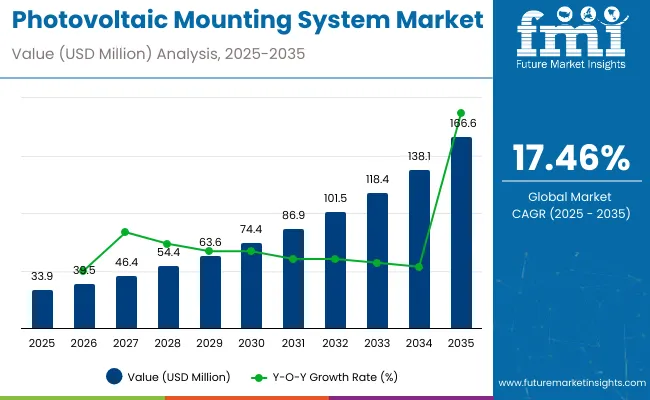
| Metrics | Values |
|---|---|
| Industry Size (2025E) | USD 33.9 million |
| Industry Value (2035F) | USD 166.6 million |
| CAGR (2025 to 2035) | 17.46% |
The photovoltaic (PV) mounting systems market is evolving with the integration of smart technologies such as AI-powered solar tracking, IoT-enabled monitoring, predictive maintenance, and autonomous terrain adaptation. These innovations are helping manufacturers and developers maximize energy yield, reduce O&M costs, and improve system resilience under variable weather and terrain conditions.
Nextracker:
Nextracker integrates AI and machine learning in its solar tracking systems, including the TrueCapture™ platform, which automatically adjusts panel tilt angles based on real-time weather and site conditions. Their smart stow technology protects arrays during extreme weather, while their digital monitoring tools enable performance analytics and predictive maintenance.
Array Technologies:
Array Technologies offers SmarTrack™ software, an AI-powered solution that adapts to terrain and diffuse sunlight to optimize backtracking and increase energy production. Their tracking systems are designed for durability and reduced maintenance, with intelligent terrain-following capabilities and real-time data integration.
ARCTECH:
ARCTECH's SkyLine II and SkySmart series employ smart multi-point drive technology, integrated with AI-based controllers for dynamic tilt optimization. Their systems provide automatic weather response, intelligent stow, and remote diagnostics, ensuring high efficiency and low O&M costs in varied terrains.
Grace Solar:
Grace Solar features the GS-Light Smart Tracker, which includes AI-powered terrain recognition, dual power supply (solar + lithium), and real-time tilt control. The system supports remote monitoring, emergency stop, and intelligent stow functions, making it suitable for complex and rugged installations.
GameChange Solar:
GameChange’s Genius Tracker™ integrates sensors for wind, snow, and humidity, along with AI-driven optimization for bifacial modules. Its smart automation system improves energy capture while enabling predictive fault detection and efficient load management.
PV Hardware (PVH):
PV Hardware deploys AI-enhanced trackers with advanced stow optimization and adaptive positioning in extreme environments. Their centralized monitoring platform enables large-scale asset management with real-time performance tracking and preventive diagnostics to extend system longevity.
The photovoltaic mounting system market is poised for steady growth, with key segments such as ground-mounted systems and fixed PV mounting systems driving significant demand. Ground-mounted systems are projected to dominate the market, while fixed PV mounting systems will continue to be the preferred technology for photovoltaic installations, ensuring stability and efficiency.
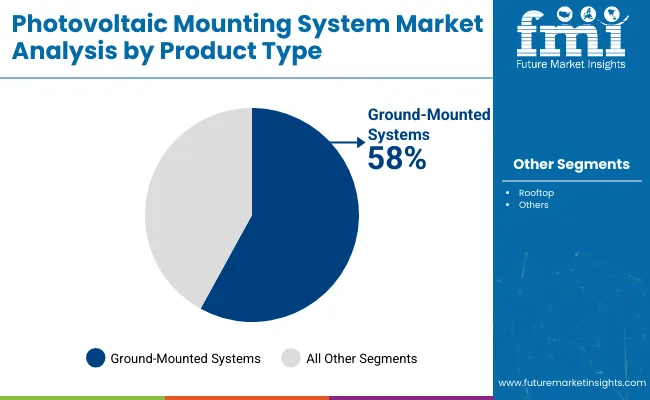
Ground-mounted photovoltaic mounting systems are expected to capture 58% of the market share by 2025. These systems are preferred for large-scale solar installations due to their flexibility, ease of installation, and ability to accommodate a high number of solar panels.
Ground-mounted systems are widely used in utility-scale solar farms, as they offer better space utilization and are easily adjustable to optimize energy production. These systems provide increased efficiency in areas with ample land and are capable of withstanding harsh weather conditions. Leading companies in the market, such as First Solar, Schletter, and PV Hardware, offer advanced ground-mounted systems designed to provide robust support for solar panels while maximizing energy output.
Additionally, ground-mounted systems can be designed to include tracking technology, allowing the panels to follow the sun's movement and further enhancing their performance. The increasing demand for renewable energy solutions, coupled with the push for large-scale solar energy production, will continue to drive the adoption of ground-mounted systems, solidifying their dominant position in the photovoltaic mounting system market.
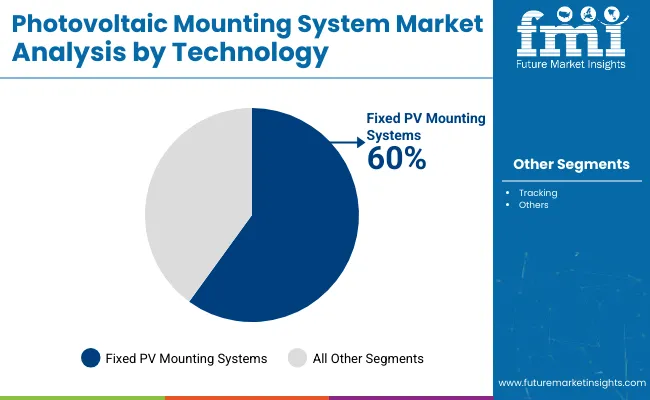
Fixed PV mounting systems are expected to capture 60% of the market share by 2025, making them the dominant technology type in the photovoltaic mounting system market. These systems are commonly used in both residential and commercial solar installations, as they provide a cost-effective and simple solution for mounting solar panels. Fixed PV mounting systems are designed to hold the panels at a fixed angle, optimizing solar energy absorption for specific geographic locations.
Their simplicity in design, lower maintenance requirements, and cost-effectiveness make them an attractive choice for homeowners, businesses, and smaller solar power projects. Leading manufacturers such as Trina Solar, JinkoSolar, and SMA Solar Technology are continually innovating and improving fixed PV mounting systems, ensuring their long-term durability and efficiency.
Fixed systems are well-suited for areas with less available space for installation or regions where land costs are higher, making them an ideal option for urban environments. As the demand for solar power continues to rise, particularly for residential and commercial use, fixed PV mounting systems are expected to remain a significant segment in the market, supporting the growth of the photovoltaic mounting system industry.
The industry plays an influential role in establishing or adapting a solar power plant because, among other considerations, it should meet the long-term durability and ease of installation with compliance. Use material durability and structural integrity as per end user and manufacturer preferences, ensuring that it is capable of sustaining harsh environmental conditions over decades.
Manufacturers also must pay higher production costs and comply with stringent conditions while being warranted within the scope of the local codes of construction and safety. Installers and contractors look at flexibility during installation, cost, and industry demand. Hence, these designs shall offer maximum flexibility in terms of minimizing labor time and ensuring acceptance from the customer side.
End users, such as the residents and commercial collectors, tend to be biased toward assurance, and their taking or perception of the system factor would lead to demand driven by the return on investment and reliability. For most end users, regulatory compliance would not be a direct concern, but upstream players must ensure that all systems meet the legal and structural standards. This industry is developing through the rising process of adoption of renewable energy, with a need as well for high-performance yet cheap and easy-to-install solutions.
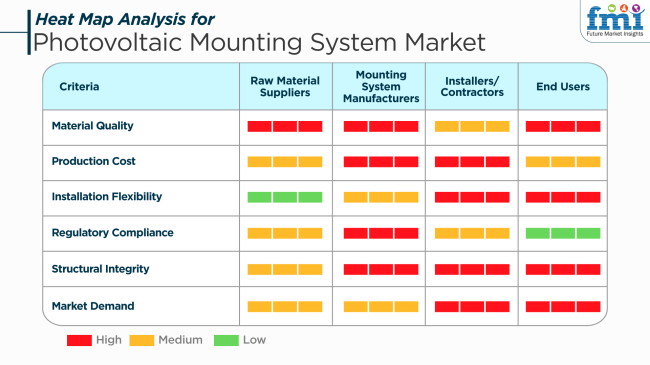
The industry is growing at an unprecedented rate due to the global thrust towards renewable energy sources. Nevertheless, this growth does enjoy a fair share of risks. Most of the risks arise as a consequence of a strong dependence on solar energy.
Solar energy adoption has increased mainly due to government support, subsidies, and climate targets, but the high capital cost for installation, especially for good-quality mounting systems, can deter development in price-sensitive regions. Spatial constraints in urban settings that hinder the setting up of conventional mounting structures may thus impede the industry's growth in densely populated areas.
In general, operations create demand for mountings that are extremely strong and standardized, particularly in the context of long-term durability and safety viewed against changing environmental conditions. Some manufacturers, in their zeal for low costs and under competition, may jeopardize the integrity of their products.
Further sophistication, such as intelligent and adjustable systems in mounting frameworks, thus creates added variables for these complex structures, requiring advanced engineering solutions and denser maintenance protocols, thereby increasing operational costs and failure risks in the event of neglect.
There is, of course, exposure to technological risks due to the rapidly changing solar panel technologies. For example, the introduction of bifacial and larger-format solar panels brings about changes in the designs of mounting systems that have to be complemented.
Those who fall behind on these technological advancements run great risks of bringing obsolete products to the industry. In addition, with increasing digitalization, mounting systems are more and more expected to support sensors and tracking features, which need continuous R&D investment, thus putting financial pressure on smaller players.
On a more general scale, political and environmental risks have a leverage effect on the supply chain and production processes. Global tensions, from trade wars to regional conflicts, may affect the supply chain of primary raw materials such as aluminum and steel. Enactment of environmental regulations to address the carbon footprint of solar infrastructure places an additional burden on manufacturers to consider green materials and clean production, which potentially could increase costs and burden for compliance burdens.
Competitive risk is hitting hard in this fragmented and fast-paced industry. Here, the demand side consists of a plethora of players at both global and regional levels vying for price and innovation. This zealous competition usually creates price wars, whose acrimonious climate eats into profit margins and threatens long-term sustainability for a number of these companies. Overreliance on a few selected customers or so-called regional industries, however, predisposes firms to a higher degree of vulnerability should those linkages be severed or demand for these products suddenly taper.
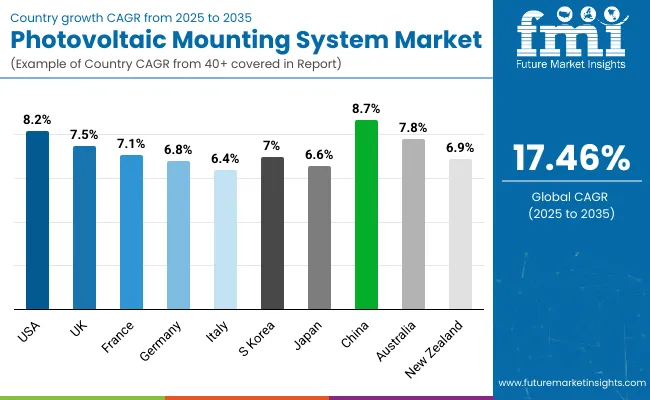
| Countries | CAGR (2025 to 2035) |
|---|---|
| USA | 8.2% |
| UK | 7.5% |
| France | 7.1% |
| Germany | 6.8% |
| Italy | 6.4% |
| South Korea | 7% |
| Japan | 6.6% |
| China | 8.7% |
| Australia | 7.8% |
| New Zealand | 6.9% |
The USA industry is projected to grow at a CAGR of 8.2% during the period 2025 to 2035 through increasing solar project installations and favorable policy conditions for renewable energy infrastructure. The shift to utility-scale solar electricity generation and expansion in distributed solar projects in states such as California, Texas, and Florida are fueling growth in fixed-tilt as well as tracking mounting systems. Increasing focus on carbon reduction and chasing net-zero targets is also driving industry activity.
Key players in the USA industry include Array Technologies, Unirac, and Solar FlexRack, each leveraging innovation to provide cost-effective, durable mounting solutions. Increased adoption of smart tracking technologies that optimize energy output is also driving industry trends. Commercial and industrial uses are driving the trend of rooftop solar installations, giving rise to roof mounts as well as ground mounts on utility projects.
The UK industry is expected to register a CAGR of 7.5% from 2025 to 2035, spurred by national decarbonization targets and the rapid advancement of solar capacity additions. Trends towards local clean energy generation, combined with rising investments in solar farms, are fueling strong demand for ground-mounted tracking and fixed systems. Residential and community-scale rooftop installations are contributing to industry dynamics.
Leading industry players such as K2 Systems, Schletter Group, and Sunfixings are offering specialized systems tailored to the UK's own climate and structural codes. Solar deployment growth in northern and urban regions is compelling innovation in weather-resistant and space-efficient solutions. Government support schemes and renewable obligation schemes continue to stimulate installations within both urban and rural settings.
The industry of France is poised to grow at a CAGR of 7.1% in the period 2035, driven by a shifting regulatory landscape favoring solar adoption across urban and agricultural lands. Large-scale solar tender programs in national energy transition plans are leading to greater demand for robust ground-mounted solutions, particularly in rural and semi-urban regions.
Major industry stakeholders like Mecosun and Systovi are contributing to industry growth by providing innovative structural designs to address the two-way utilization of land for agriculture and solar. France is also seeing increased uptake of building-integrated photovoltaic (BIPV) systems, further underscoring the demand for flexible and modular mounting solutions. The push for energy independence in industrial and public sectors is also contributing to demand.
Germany's industry is expected to record a CAGR of 6.8% over the forecast period because of the Energiewende program and the increasing penetration of solar in commercial as well as residential sectors. Renewable electricity policy support incentives and government support for the installation of solar on public buildings are also fueling the use of rooftops as well as ground-mounted systems.
Industry leaders such as Mounting Systems GmbH, Renusol, and Schletter are setting the pace, offering engineering-optimized solutions specific to Germany's building codes and climatic requirements. The comeback of small-scale installations, along with continued utility-scale project development, supports a balanced demand scenario. Emphasis on durability, recyclability, and aesthetic integration remains robust in the German industry.
Italy's industry is expected to grow in the range of 2025 to 2035 at a CAGR of 6.4%, which is mainly led by growth in rooftop solar adoption in residential and commercial segments. Incentives of tax deductions for investing in solar and for energy efficiency improvement are fostering local demand. Regional development plans are also encouraging solar plans in southern Italy and island areas.
Significant industry players include Sunerg Solar and Esdec, offering flexible systems that can be adapted to Italy's varied architectural and environmental situations. Ground-mounted systems are still substantial, especially in agrivoltaic installations for double land use. Seismic and lightweight constructions are increasingly becoming significant with regard to specific regional geophysical conditions.
South Korea's industry is expected to grow at a CAGR of 7% over the forecast period, supported by government strategies to diversify energy sources and reduce fossil fuel dependence. The Renewable Energy 3020 Implementation Plan is encouraging increased investments in utility-scale and distributed solar systems, particularly in coastal and industrial regions.
Companies such as Hae Sung Solar and OCI Power are leading innovations in high-mountain elevation mounting systems and corrosion-resistant solutions suitable for South Korea's terrain and climatic variations. Building and public infrastructure-based, urban-oriented installations are opening up industries for high-density, space-efficient rooftop mounting systems. The intersection of industrial decarbonization targets and the coherence of energy policy is also fuelling growth.
Japan's industry is projected to register a 6.6% CAGR during 2025 to 2035, spearheaded by Japan's commitment to achieve net emissions of zero by 2050 and a change towards distributed solar infrastructure. The unavailability of horizontal land has surged the utilization of rooftop and upper structures in towns and mountain areas, inducing structure adaptability innovation.
Key manufacturers such as Mitsui Chemicals Tohcello and West Holdings Corporation are offering advanced systems tailored to seismic regions and extreme wind-load requirements. Carport-based solar plants and floating PV systems are becoming more popular, which is forcing diversification in mounting designs. Industry momentum is also being propelled by municipal support for community-scale solar projects.
The Chinese industry is anticipated to experience the highest CAGR of 8.7% over the forecast period, with unmatched goals of solar capacity additions and prevailing leadership in world PV supply chains. Government regulations to promote rural electrification and industrial decarbonization are driving large-scale utility and distributed installations.
Pioneering domestic players such as Clenergy, Antaisolar, and Xiamen Grace Solar Technology are leading the way in manufacturing fixed and tracking systems suitable for various geographic locations. AI-based tracking systems and anti-corrosive materials are improving efficiency and lifespan under varied climatic conditions. A strategic focus on exporting to global countries is also fueling product development.
Australia's industry will grow at a CAGR of 7.8% through 2035, fueled by the strong uptake of residential and utility-scale solar in Queensland, New South Wales, and South Australia. Favorable solar irradiation combined with friendly net metering regulations is encouraging the large-scale deployment of rooftop as well as ground-mounted systems.
Industry players like Clenergy Australia and Soltech Energy are introducing long-term, UV-resistant, and wind-tolerant structures that are made to suit regional needs. Growing demand for agrivoltaic programs and commercial rooftop solar is creating opportunities for customized and modular mounting systems. Government incentives and carbon reduction commitments are also raising investment levels.
New Zealand's industry is expected to post a CAGR of 6.9% over the 2025 to 2035 timeframe, driven by national targets to produce 100% renewable electricity and increased interest in decentralized solar power. The industry is gaining momentum with growing installations on commercial buildings, farms, and schools
Companies such as SolarMounts NZ and Enasolar are offering systems that are compatible with New Zealand's building code and fluctuating climatic conditions. Corrosion resistance and expandable modularity are influencing product design. Facilitative regulatory environments and domestic energy policy are pivotal in elevating industry participation in the North and South Islands.
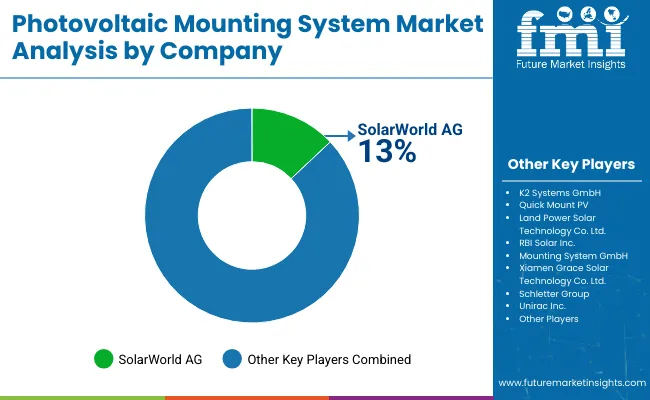
The industry has a highly competitive environment, with specialized solar racking companies focusing on structural integrity, modularity, and ease of installation. The likes of Schletter Group, Unirac Inc., and K2 Systems GmbH dominate the industry by providing efficacious mounting solutions for residential, commercial as well as utility-scale projects. The companies enjoy a competitive advantage in the worldwide deployment of solar by virtue of their patented tracking technologies, wind-resistant structures, and lightweight materials.
Through engagements in strategic partnerships with solar panel manufacturers, energy developers, and engineering, procurement, and construction (EPC) firms, the industry leaders have been advancing. Firms such as SolarWorld AG and RBI Solar Inc. emphasize integrated racking solutions based on advanced corrosion resistance and aerodynamics to enhance system operability and lifetime in tougher environments. Quick Mount PV and Mounting System GmbH have, meanwhile, fortified their place in the residential rooftop sector with certified waterproof flashing systems and extra-durable mounts for sloped and flat roofs.
Chinese manufacturers, including Land Power Solar, Xiamen Grace Solar and Clenergy, are creating a buzz by offering cheap and readily customizable mounting solutions for utility-scale solar farms. These companies leverage their vertically integrated supply chains and aggressive pricing strategies to take advantage of the growing global demand for sustainable energy infrastructure. Therefore, Tata International Ltd. is gradually increasing its footprint by focusing on emerging solar industries across Asia and Africa with low-cost and scalable racking solutions.
Innovation is the core area for further growth of this industry, and industry leaders invest in solar tracking systems, adjustable tilt mounts, and automated installation systems. The companies that can leverage AI for optimization and analytics of wind loads will have the upper hand over industry competition as solar takes off in the coming decades.
| Report Attributes | Details |
|---|---|
| Current Total Market Size (2025) | USD 33.9 million |
| Projected Market Size (2035) | USD 166.6 million |
| CAGR (2025 to 2035) | 17.46% |
| Base Year for Estimation | 2024 |
| Historical Period | 2020 to 2024 |
| Projections Period | 2025 to 2035 |
| Quantitative Units | USD million for value |
| Product Types Analyzed (Segment 1) | Ground-mounted, Rooftop |
| Technology Types Analyzed (Segment 2) | Fixed, Tracking (Single-axis, Dual-axis) |
| End Use Sectors Covered (Segment 3) | Residential, Commercial, Civic Utilities |
| Regions Covered | North America; Latin America; Europe; Asia Pacific; Middle East & Africa |
| Countries Covered | United States, China, India, Australia, Germany, Japan, Brazil |
| Key Players Influencing the Market | Schletter Group, Unirac Inc., SolarWorld AG, K2 Systems GmbH, Quick Mount PV, RBI Solar Inc., Clenergy, Tata International, Van der Valk Solar Systems BV, Xiamen Grace Solar Technology, Land Power Solar Technology |
| Additional Attributes | Dollar sales by product and technology type, regional investment trends, solar policy impact, innovation in mounting materials and control software, growth in floating and utility-scale solar projects |
| Customization and Pricing | Customization and Pricing Available on Request |
The industry is projected to be valued at USD 33.9 million in 2025.
The industry is forecasted to reach USD 166.6 million by 2035.
China is leading with a projected 8.7% growth rate.
Ground-mounted photovoltaic mounting systems are the most dominant type, especially for utility-scale solar farms.
Leading companies include Schletter Group, Unirac Inc., SolarWorld AG, K2 Systems GmbH, Quick Mount PV, Land Power Solar Technology Co. Ltd., RBI Solar Inc., Mounting System GmbH, Xiamen Grace Solar Technology Co. Ltd., Clenergy, Tata International Ltd., Xiamen Universe Solar Tech. Co. Ltd., Xiamen Corigy New Energy Technology Co. Ltd., PV Racking, and Van der Valk Solar Systems BV.






Full Research Suite comprises of:
Market outlook & trends analysis
Interviews & case studies
Strategic recommendations
Vendor profiles & capabilities analysis
5-year forecasts
8 regions and 60+ country-level data splits
Market segment data splits
12 months of continuous data updates
DELIVERED AS:
PDF EXCEL ONLINE
UK Photovoltaic Mounting System Market Growth - Trends & Forecast 2025 to 2035
Europe Photovoltaic Mounting System Market – Trends & Forecast 2025 to 2035
Photovoltaic Grade High Purity Crystalline Silicon Market Size and Share Forecast Outlook 2025 to 2035
Solar Photovoltaic (PV) Market Size and Share Forecast Outlook 2025 to 2035
Solar Photovoltaic Wafer Market
On-Site Solar Power Market Growth – Trends & Forecast 2025 to 2035
Thin Film Photovoltaics Market Size and Share Forecast Outlook 2025 to 2035
Thin Film Photovoltaic Modules Market
High Concentration Photovoltaics Market Analysis by Type of Power Generation, Application, and Region Through 2035
Special Sealant for Photovoltaic Modules Market Forecast and Outlook 2025 to 2035
Building Integrated Photovoltaics Market - Solar & Architecture
Silicone Sealants for Photovoltaic Assembly Market Forecast and Outlook 2025 to 2035
Semiconductors in Solar PV Power Systems Market Growth - Trends & Forecast 2025 to 2035
Engine Mounting Brackets Market
Telecom Mounting Hardware Market Size and Share Forecast Outlook 2025 to 2035
Surface Mounting Distribution Panel Market Size and Share Forecast Outlook 2025 to 2035
Solar Panel Mounting Structures Market Growth - Trends & Forecast 2025 to 2035
Transmission Mounting Bracket Market
Binoculars and Mounting Solutions Market Growth - Trends & Forecast 2025 to 2035
India Solar Panel Mounting Structure Market Analysis and Forecast for 2025 to 2035

Thank you!
You will receive an email from our Business Development Manager. Please be sure to check your SPAM/JUNK folder too.
Chat With
MaRIA